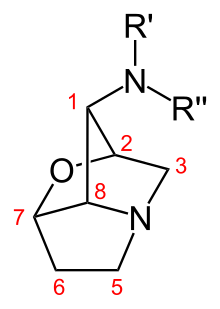
Forage is a plant material eaten by grazing livestock. Historically, the term forage has meant only plants eaten by the animals directly as pasture, crop residue, or immature cereal crops, but it is also used more loosely to include similar plants cut for fodder and carried to the animals, especially as hay or silage.

Lolium is a genus of tufted grasses in the bluegrass subfamily (Pooideae). It is often called ryegrass, but this term is sometimes used to refer to grasses in other genera.

Ornamental grasses are grasses grown as ornamental plants. Ornamental grasses are popular in many colder hardiness zones for their resilience to cold temperatures and aesthetic value throughout fall and winter seasons.

Festuca (fescue) is a genus of flowering plants belonging to the grass family Poaceae. They are evergreen or herbaceous perennial tufted grasses with a height range of 10–200 cm (4–79 in) and a cosmopolitan distribution, occurring on every continent except Antarctica. The genus is closely related to ryegrass (Lolium), and recent evidence from phylogenetic studies using DNA sequencing of plant mitochondrial DNA shows that the genus lacks monophyly. As a result, plant taxonomists have moved several species, including the forage grasses tall fescue and meadow fescue, from the genus Festuca into the genus Lolium, or alternatively into the segregate genus Schedonorus.

Festuca ovina, sheep's fescue or sheep fescue, is a species of grass. It is sometimes confused with hard fescue.
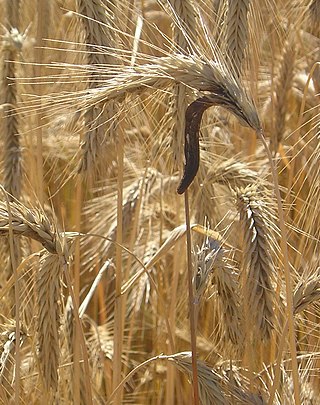
Claviceps purpurea is an ergot fungus that grows on the ears of rye and related cereal and forage plants. Consumption of grains or seeds contaminated with the survival structure of this fungus, the ergot sclerotium, can cause ergotism in humans and other mammals. C. purpurea most commonly affects outcrossing species such as rye, as well as triticale, wheat and barley. It affects oats only rarely.

Festuca pratensis, meadow fescue is a perennial species of grass, which is often used as an ornamental in gardens, and is also an important forage crop. It grows in meadows, roadsides, old pastures, and riversides on moist, rich soils, especially on loamy and heavy soils.

Epichloë is a genus of ascomycete fungi forming an endophytic symbiosis with grasses. Grass choke disease is a symptom in grasses induced by some Epichloë species, which form spore-bearing mats (stromata) on tillers and suppress the development of their host plant's inflorescence. For most of their life cycle however, Epichloë grow in the intercellular space of stems, leaves, inflorescences, and seeds of the grass plant without incurring symptoms of disease. In fact, they provide several benefits to their host, including the production of different herbivore-deterring alkaloids, increased stress resistance, and growth promotion.
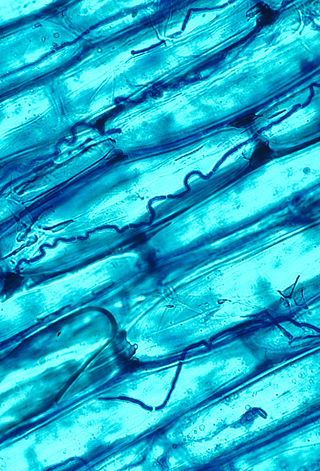
Epichloë coenophiala is a systemic and seed-transmissible endophyte of tall fescue, a grass endemic to Eurasia and North Africa, but widely naturalized in North America, Australia and New Zealand. The endophyte has been identified as the cause of the "fescue toxicosis" syndrome sometimes suffered by livestock that graze the infected grass. Possible symptoms include poor weight gain, elevated body temperature, reduced conception rates, agalactia, rough hair coat, fat necrosis, loss of switch and ear tips, and lameness or dry gangrene of the feet. Because of the resemblance to symptoms of ergotism in humans, the most likely agents responsible for fescue toxicosis are thought to be the ergot alkaloids, principally ergovaline produced by E. coenophiala.

Ergovaline is an ergopeptine and one of the ergot alkaloids. It is usually found in endophyte-infected species of grass like Tall fescue or Perennial Ryegrass. It is toxic to cattle feeding on infected grass, probably because it acts as a vasoconstrictor.
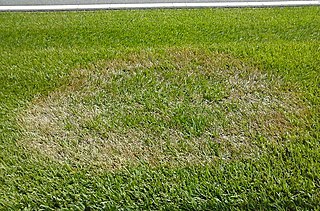
Brown patch is a common turfgrass fungal disease that is caused by species in the genus Rhizoctonia, usually Rhizoctonia solani. Brown patch can be found in all of the cool season turfgrasses found in the United States. Brown patch is most devastating to: Bentgrass, ryegrass, Annual bluegrass, and Tall fescue. Brown patch is also found in Kentucky bluegrass and Fine fescue but this is rare or does minimal damage. Brown patch is known as a foliar disease, so it does not have any effect on the crown or roots of the turf plant.

A loline alkaloid is a member of the 1-aminopyrrolizidines, which are bioactive natural products with several distinct biological and chemical features. The lolines are insecticidal and insect-deterrent compounds that are produced in grasses infected by endophytic fungal symbionts of the genus Epichloë. Lolines increase resistance of endophyte-infected grasses to insect herbivores, and may also protect the infected plants from environmental stresses such as drought and spatial competition. They are alkaloids, organic compounds containing basic nitrogen atoms. The basic chemical structure of the lolines comprises a saturated pyrrolizidine ring, a primary amine at the C-1 carbon, and an internal ether bridge—a hallmark feature of the lolines, which is uncommon in organic compounds—joining two distant ring carbons. Different substituents at the C-1 amine, such as methyl, formyl, and acetyl groups, yield loline species that have variable bioactivity against insects. Besides endophyte–grass symbionts, loline alkaloids have also been identified in some other plant species; namely, Adenocarpus species and Argyreia mollis.

Plant use of endophytic fungi in defense occurs when endophytic fungi, which live symbiotically with the majority of plants by entering their cells, are utilized as an indirect defense against herbivores. In exchange for carbohydrate energy resources, the fungus provides benefits to the plant which can include increased water or nutrient uptake and protection from phytophagous insects, birds or mammals. Once associated, the fungi alter nutrient content of the plant and enhance or begin production of secondary metabolites. The change in chemical composition acts to deter herbivory by insects, grazing by ungulates and/or oviposition by adult insects. Endophyte-mediated defense can also be effective against pathogens and non-herbivory damage.

Festuca gigantea, giant fescue, is a plant species in the grass family, Poaceae.
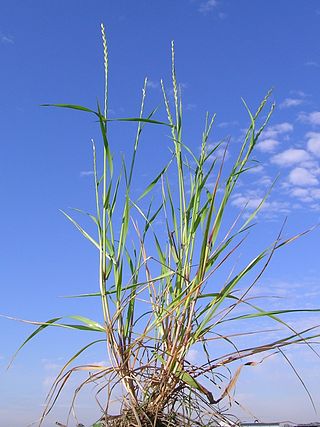
Lolium rigidum is a species of annual grass. Common names by which it is known include annual ryegrass, a name also given to Italian ryegrass, rigid ryegrass, stiff darnel, Swiss ryegrass and Wimmera ryegrass. It is a native of southern Europe, northern Africa, the Middle East and the Indian subcontinent and is grown as a forage crop, particularly in Australia, where it is also a serious and economically damaging crop weed.
Perennial ryegrass staggers is poisoning by peramine, lolitrem B, and other toxins that are contained in perennial ryegrass, and produced by the endophyte fungus Epichloë festucae which can be present in all parts of the grass plant, but tends to be concentrated in the lower part of the leaf sheaths, the flower stalks and seeds. This condition can affect horses, cattle, sheep, farmed deer and llamas. It regularly occurs in New Zealand and is known spasmodically from Australia, North and South America, and Europe.

Lolitrem B is one of many toxins produced by a fungus called Epichloë festucae var. lolii), which grows in Lolium perenne. The fungus is symbiotic with the ryegrass; it doesn't harm the plant, and the toxins it produces kill insects that feed on ryegrass. Lolitrem B is one of these toxins, but it is also harmful to mammals. The shoots and flowers of infected ryegrass have especially high concentrations of lolitrem B, and when livestock eat too much of them, they get perennial ryegrass staggers. At low doses the animals have tremors, and at higher doses they stagger, and at higher yet doses the animals become paralyzed and die. The blood pressure of the animals also goes up. The effect of the lolitrem B comes on slowly and fades out slowly, as it is stored in fat after the ryegrass is eaten. The condition is especially common in New Zealand and Australia, and plant breeders there have been trying to develop strains of fungus that produce toxins only harmful to pests, and not to mammals.
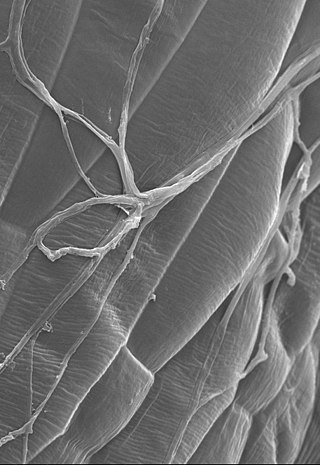
Epichloë festucae is a systemic and seed-transmissible endophytic fungus of cool season grasses.

Epichloë hybrida is a systemic, asexual and seed-transmissible endophyte of perennial ryegrass within the genus Epichloë. An interspecies allopolyploid of two haploid parent species Epichloë typhina and Epichloë festucae var. lolii, E. hybrida was first identified in 1989, recognized as an interspecific hybrid in 1994, but only formally named in 2017. Previously this species was often informally called Epichloë typhina x Epichloë festucae var. lolii, or referenced by the identifier of its most well-studied strain, Lp1. Epichloë hybrida is a symbiont of perennial ryegrass where its presence is almost entirely asymptomatic. The species has been commercialized for the benefits of its anti-insect compounds in a pasture setting, although it is now more commonly used as an experimental model system for studying interspecific hybridization in fungi.
Epichloë siegelii is a hybrid asexual species in the fungal genus Epichloë.

